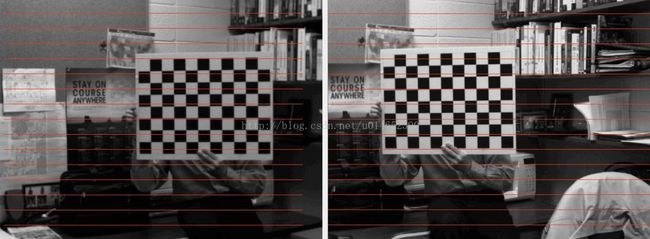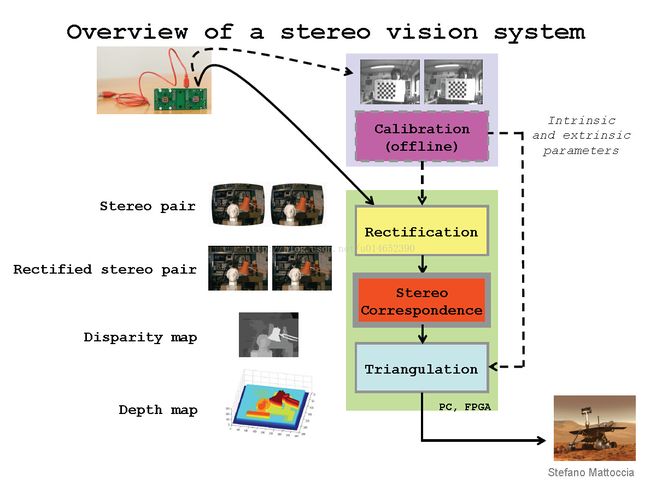OpenCV双目视觉之立体校正
本文试图从宏观的视角,解释这些个问题:这个校正是干嘛的,为啥要作这个立体校正呢,以及如何做。本文分享给像我一样“白手起家”的小伙伴们,要进行更深入的研究,可以参考文章后面的干货列表。
如果用一句话来解释立体校正,那么,敲黑板,划重点“立体校正就是,把实际中非共面行对准的两幅图像,校正成共面行对准。”这话读起来有点深奥,配个图,就好理解啦!

(1)未校正以前左右眼视图

(2)校正后的左右眼视图
果然一图胜似千言万语啊。
好了,到这里,第一个问题,你应该清楚了吧,不清楚的话,请举手!
那么接下来第二个问题来了,我把这左右眼图像对齐了,有什么用呢?我是没事找点事情干吗?我确实是闲来没事,但是OpenCV不会。先给张图感受一下~

我们知道,立体匹配是三维重建、立体导航、非接触测距等技术的关键步骤,它通过匹配两幅或者多幅图像来获取深度信息。并且广泛应用于,工业生产自动化、流水线控制、无人驾驶汽车(测距,导航)、安防监控、遥感图像分析、机器人智能控制等方面。”而立体图像校正是降低立体匹配计算复杂性的最有效方法之一。 因为当两个图像平面是完全共面行对准时,立体匹配从二维搜索降至一维搜索,并且可以过滤掉无匹配点。但是,在现实的双目立体视觉系统中,是不存在完全的共面行对准的两个摄像机图像平面的,所以我们要进行立体校正。
最后一个问题,那么作为小白的我,怎么做立体校正呢?
OpenCV的大致流程是这样的:
具体做法,参考调用代码:
#include "opencv2/calib3d/calib3d.hpp"
#include "opencv2/highgui/highgui.hpp"
#include "opencv2/imgproc/imgproc.hpp"
#include
#include
#include
#include
#include
#include
#include
#include
using namespace cv;
using namespace std;
static void StereoCalib(const vector& imagelist, Size boardSize, bool useCalibrated=true, bool showRectified=true)
{
if( imagelist.size() % 2 != 0 )
{
cout << "Error: the image list contains odd (non-even) number of elements\n";
return;
}
bool displayCorners = true;//true;
const int maxScale = 2;
const float squareSize = 1.f; // Set this to your actual square size
// ARRAY AND VECTOR STORAGE:
vector > imagePoints[2];
vector > objectPoints;
Size imageSize;
int i, j, k, nimages = (int)imagelist.size()/2;
imagePoints[0].resize(nimages);
imagePoints[1].resize(nimages);
vector goodImageList;
for( i = j = 0; i < nimages; i++ )
{
for( k = 0; k < 2; k++ )
{
const string& filename = imagelist[i*2+k];
Mat img = imread(filename, 0);
if(img.empty())
break;
if( imageSize == Size() )
imageSize = img.size();
else if( img.size() != imageSize )
{
cout << "The image " << filename << " has the size different from the first image size. Skipping the pair\n";
break;
}
bool found = false;
vector& corners = imagePoints[k][j];
for( int scale = 1; scale <= maxScale; scale++ )
{
Mat timg;
if( scale == 1 )
timg = img;
else
resize(img, timg, Size(), scale, scale);
found = findChessboardCorners(timg, boardSize, corners,
CV_CALIB_CB_ADAPTIVE_THRESH | CV_CALIB_CB_NORMALIZE_IMAGE);
if( found )
{
if( scale > 1 )
{
Mat cornersMat(corners);
cornersMat *= 1./scale;
}
break;
}
}
if( displayCorners )
{
cout << filename << endl;
Mat cimg, cimg1;
cvtColor(img, cimg, COLOR_GRAY2BGR);
drawChessboardCorners(cimg, boardSize, corners, found);
double sf = 640./MAX(img.rows, img.cols);
resize(cimg, cimg1, Size(), sf, sf);
imshow("corners", cimg1);
char c = (char)waitKey(500);
if( c == 27 || c == 'q' || c == 'Q' ) //Allow ESC to quit
exit(-1);
}
else
putchar('.');
if( !found )
break;
cornerSubPix(img, corners, Size(11,11), Size(-1,-1),
TermCriteria(CV_TERMCRIT_ITER+CV_TERMCRIT_EPS,
30, 0.01));
}
if( k == 2 )
{
goodImageList.push_back(imagelist[i*2]);
goodImageList.push_back(imagelist[i*2+1]);
j++;
}
}
cout << j << " pairs have been successfully detected.\n";
nimages = j;
if( nimages < 2 )
{
cout << "Error: too little pairs to run the calibration\n";
return;
}
imagePoints[0].resize(nimages);
imagePoints[1].resize(nimages);
objectPoints.resize(nimages);
for( i = 0; i < nimages; i++ )
{
for( j = 0; j < boardSize.height; j++ )
for( k = 0; k < boardSize.width; k++ )
objectPoints[i].push_back(Point3f(k*squareSize, j*squareSize, 0));
}
cout << "Running stereo calibration ...\n";
Mat cameraMatrix[2], distCoeffs[2];
cameraMatrix[0] = Mat::eye(3, 3, CV_64F);
cameraMatrix[1] = Mat::eye(3, 3, CV_64F);
Mat R, T, E, F;
double rms = stereoCalibrate(objectPoints, imagePoints[0], imagePoints[1],
cameraMatrix[0], distCoeffs[0],
cameraMatrix[1], distCoeffs[1],
imageSize, R, T, E, F,
TermCriteria(CV_TERMCRIT_ITER+CV_TERMCRIT_EPS, 100, 1e-5),
CV_CALIB_FIX_ASPECT_RATIO +
CV_CALIB_ZERO_TANGENT_DIST +
CV_CALIB_SAME_FOCAL_LENGTH +
CV_CALIB_RATIONAL_MODEL +
CV_CALIB_FIX_K3 + CV_CALIB_FIX_K4 + CV_CALIB_FIX_K5);
cout << "done with RMS error=" << rms << endl;
// CALIBRATION QUALITY CHECK
// because the output fundamental matrix implicitly
// includes all the output information,
// we can check the quality of calibration using the
// epipolar geometry constraint: m2^t*F*m1=0
double err = 0;
int npoints = 0;
vector lines[2];
for( i = 0; i < nimages; i++ )
{
int npt = (int)imagePoints[0][i].size();
Mat imgpt[2];
for( k = 0; k < 2; k++ )
{
imgpt[k] = Mat(imagePoints[k][i]);
undistortPoints(imgpt[k], imgpt[k], cameraMatrix[k], distCoeffs[k], Mat(), cameraMatrix[k]);
computeCorrespondEpilines(imgpt[k], k+1, F, lines[k]);
}
for( j = 0; j < npt; j++ )
{
double errij = fabs(imagePoints[0][i][j].x*lines[1][j][0] +
imagePoints[0][i][j].y*lines[1][j][1] + lines[1][j][2]) +
fabs(imagePoints[1][i][j].x*lines[0][j][0] +
imagePoints[1][i][j].y*lines[0][j][1] + lines[0][j][2]);
err += errij;
}
npoints += npt;
}
cout << "average reprojection err = " << err/npoints << endl;
// save intrinsic parameters
FileStorage fs("intrinsics.yml", CV_STORAGE_WRITE);
if( fs.isOpened() )
{
fs << "M1" << cameraMatrix[0] << "D1" << distCoeffs[0] <<
"M2" << cameraMatrix[1] << "D2" << distCoeffs[1];
fs.release();
}
else
cout << "Error: can not save the intrinsic parameters\n";
Mat R1, R2, P1, P2, Q;
Rect validRoi[2];
stereoRectify(cameraMatrix[0], distCoeffs[0],
cameraMatrix[1], distCoeffs[1],
imageSize, R, T, R1, R2, P1, P2, Q,
CALIB_ZERO_DISPARITY, 1, imageSize, &validRoi[0], &validRoi[1]);
fs.open("extrinsics.yml", CV_STORAGE_WRITE);
if( fs.isOpened() )
{
fs << "R" << R << "T" << T << "R1" << R1 << "R2" << R2 << "P1" << P1 << "P2" << P2 << "Q" << Q;
fs.release();
}
else
cout << "Error: can not save the extrinsic parameters\n";
// OpenCV can handle left-right
// or up-down camera arrangements
bool isVerticalStereo = fabs(P2.at(1, 3)) > fabs(P2.at(0, 3));
// COMPUTE AND DISPLAY RECTIFICATION
if( !showRectified )
return;
Mat rmap[2][2];
// IF BY CALIBRATED (BOUGUET'S METHOD)
if( useCalibrated )
{
// we already computed everything
}
// OR ELSE HARTLEY'S METHOD
else
// use intrinsic parameters of each camera, but
// compute the rectification transformation directly
// from the fundamental matrix
{
vector allimgpt[2];
for( k = 0; k < 2; k++ )
{
for( i = 0; i < nimages; i++ )
std::copy(imagePoints[k][i].begin(), imagePoints[k][i].end(), back_inserter(allimgpt[k]));
}
F = findFundamentalMat(Mat(allimgpt[0]), Mat(allimgpt[1]), FM_8POINT, 0, 0);
Mat H1, H2;
stereoRectifyUncalibrated(Mat(allimgpt[0]), Mat(allimgpt[1]), F, imageSize, H1, H2, 3);
R1 = cameraMatrix[0].inv()*H1*cameraMatrix[0];
R2 = cameraMatrix[1].inv()*H2*cameraMatrix[1];
P1 = cameraMatrix[0];
P2 = cameraMatrix[1];
}
//Precompute maps for cv::remap()
initUndistortRectifyMap(cameraMatrix[0], distCoeffs[0], R1, P1, imageSize, CV_16SC2, rmap[0][0], rmap[0][1]);
initUndistortRectifyMap(cameraMatrix[1], distCoeffs[1], R2, P2, imageSize, CV_16SC2, rmap[1][0], rmap[1][1]);
Mat canvas;
double sf;
int w, h;
if( !isVerticalStereo )
{
sf = 600./MAX(imageSize.width, imageSize.height);
w = cvRound(imageSize.width*sf);
h = cvRound(imageSize.height*sf);
canvas.create(h, w*2, CV_8UC3);
}
else
{
sf = 300./MAX(imageSize.width, imageSize.height);
w = cvRound(imageSize.width*sf);
h = cvRound(imageSize.height*sf);
canvas.create(h*2, w, CV_8UC3);
}
for( i = 0; i < nimages; i++ )
{
for( k = 0; k < 2; k++ )
{
Mat img = imread(goodImageList[i*2+k], 0), rimg, cimg;
remap(img, rimg, rmap[k][0], rmap[k][1], CV_INTER_LINEAR);
imshow("单目相机校正",rimg);
waitKey();
cvtColor(rimg, cimg, COLOR_GRAY2BGR);
Mat canvasPart = !isVerticalStereo ? canvas(Rect(w*k, 0, w, h)) : canvas(Rect(0, h*k, w, h));
resize(cimg, canvasPart, canvasPart.size(), 0, 0, CV_INTER_AREA);
if( useCalibrated )
{
Rect vroi(cvRound(validRoi[k].x*sf), cvRound(validRoi[k].y*sf),
cvRound(validRoi[k].width*sf), cvRound(validRoi[k].height*sf));
rectangle(canvasPart, vroi, Scalar(0,0,255), 3, 8);
}
}
if( !isVerticalStereo )
for( j = 0; j < canvas.rows; j += 16 )
line(canvas, Point(0, j), Point(canvas.cols, j), Scalar(0, 255, 0), 1, 8);
else
for( j = 0; j < canvas.cols; j += 16 )
line(canvas, Point(j, 0), Point(j, canvas.rows), Scalar(0, 255, 0), 1, 8);
imshow("双目相机校正对齐", canvas);
waitKey();
char c = (char)waitKey();
if( c == 27 || c == 'q' || c == 'Q' )
break;
}
}
static bool readStringList( const string& filename, vector& l )
{
l.resize(0);
FileStorage fs(filename, FileStorage::READ);
if( !fs.isOpened() )
return false;
FileNode n = fs.getFirstTopLevelNode();
if( n.type() != FileNode::SEQ )
return false;
FileNodeIterator it = n.begin(), it_end = n.end();
for( ; it != it_end; ++it )
l.push_back((string)*it);
return true;
}
int main(int argc, char** argv)
{
Size boardSize;
string imagelistfn;
bool showRectified = true;
for( int i = 1; i < argc; i++ )
{
if( string(argv[i]) == "-w" )
{
if( sscanf(argv[++i], "%d", &boardSize.width) != 1 || boardSize.width <= 0 )
{
cout << "invalid board width" << endl;
return -1;
}
}
else if( string(argv[i]) == "-h" )
{
if( sscanf(argv[++i], "%d", &boardSize.height) != 1 || boardSize.height <= 0 )
{
cout << "invalid board height" << endl;
return -1;
}
}
else if( string(argv[i]) == "-nr" )
showRectified = false;
else if( string(argv[i]) == "--help" )
return -1;
else if( argv[i][0] == '-' )
{
cout << "invalid option " << argv[i] << endl;
return 0;
}
else
imagelistfn = argv[i];
}
if( imagelistfn == "" )
{
imagelistfn = "stereo_calib.xml";
boardSize = Size(9, 6);
}
else if( boardSize.width <= 0 || boardSize.height <= 0 )
{
cout << "if you specified XML file with chessboards, you should also specify the board width and height (-w and -h options)" << endl;
return 0;
}
vector imagelist;
bool ok = readStringList(imagelistfn, imagelist);
if(!ok || imagelist.empty())
{
cout << "can not open " << imagelistfn << " or the string list is empty" << endl;
return -1;
}
StereoCalib(imagelist, boardSize, true, showRectified);
return 0;
}
